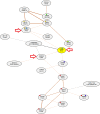Application of System Biology to Explore the Association of Neprilysin, Angiotensin-Converting Enzyme 2 (ACE2), and Carbonic Anhydrase (CA) in Pathogenesis of SARS-CoV-2
- PMID: 32572334
- PMCID: PMC7302923
- DOI: 10.1186/s12575-020-00124-6
Application of System Biology to Explore the Association of Neprilysin, Angiotensin-Converting Enzyme 2 (ACE2), and Carbonic Anhydrase (CA) in Pathogenesis of SARS-CoV-2
Abstract
Background: Coronavirus disease 2019 (COVID-19) is caused by severe acute respiratory syndrome coronavirus 2 (SARS-CoV-2) appears with common symptoms including fever, dry cough, and fatigue, as well as some less common sysmptoms such as loss of taste and smell, diarrhea, skin rashes and discoloration of fingers. COVID-19 patients may also suffer from serious symptoms including shortness of breathing, chest pressure and pain, as well as loss of daily routine habits, pointing out to a sever reduction in the quality of life. COVID-19 has afftected almost all countries, however, the United States contains the highest number of infection (> 1,595,000 cases) and deaths cases (> 95,000 deaths) in the world until May 21, 2020. Finding an influential treatment strategy against COVID-19 can be facilitated through better understanding of the virus pathogenesis and consequently interrupting the biochemical pathways that the virus may play role in human body as the current reservoir of the virus.
Results: In this study, we combined system biology and bioinformatic approaches to define the role of coexpression of angiotensin-converting enzyme 2 (ACE2), neprilysin or membrane metallo-endopeptidase (MME), and carbonic anhydrases (CAs) and their association in the pathogenesis of SARS-CoV-2. The results revealed that ACE2 as the cellular attachment site of SARS-CoV-2, neprilysin, and CAs have a great contribution together in the renin angiotensin system (RAS) and consequently in pathogenesis of SARS-CoV-2 in the vital organs such as respiratory, renal, and blood circulation systems. Any disorder in neprilysin, ACE2, and CAs can lead to increase of CO2 concentration in blood and respiratory acidosis, induction of pulmonary edema and heart and renal failures.
Conclusions: Due to the presence of ACE2-Neprilysin-CA complex in most of vital organs and as a receptor of COVID-19, it is expected that most organs are affected by SARS-CoV-2 such as inflammation and fibrosis of lungs, which may conversely affect their vital functions, temporary or permanently, sometimes leading to death. Therefore, ACE2-Neprilysin-CA complex could be the key factor of pathogenesis of SARS-CoV-2 and may provide us useful information to find better provocative and therapeutic strategies against COVID-19.
Keywords: Acute respiratory syndrome; Angiotensin-converting enzyme 2 (ACE2); COVID-19; Carbonic anhydrases (CAs); Neprilysin; Renin angiotensin system (RAS); Respiratory acidosis; SARS-CoV-2.
© The Author(s) 2020.
Conflict of interest statement
Competing InterestsThe authors declare that they have no conflict of interests.
Figures



Similar articles
-
A mechanistic model and therapeutic interventions for COVID-19 involving a RAS-mediated bradykinin storm.Elife. 2020 Jul 7;9:e59177. doi: 10.7554/eLife.59177. Elife. 2020. PMID: 32633718 Free PMC article.
-
SARS-CoV-2 pandemic and research gaps: Understanding SARS-CoV-2 interaction with the ACE2 receptor and implications for therapy.Theranostics. 2020 Jun 12;10(16):7448-7464. doi: 10.7150/thno.48076. eCollection 2020. Theranostics. 2020. PMID: 32642005 Free PMC article. Review.
-
Angiotensin-converting enzyme 2 (ACE2), SARS-CoV-2 and the pathophysiology of coronavirus disease 2019 (COVID-19).J Pathol. 2020 Jul;251(3):228-248. doi: 10.1002/path.5471. Epub 2020 Jun 10. J Pathol. 2020. PMID: 32418199 Free PMC article. Review.
-
Testing the efficacy and safety of BIO101, for the prevention of respiratory deterioration, in patients with COVID-19 pneumonia (COVA study): a structured summary of a study protocol for a randomised controlled trial.Trials. 2021 Jan 11;22(1):42. doi: 10.1186/s13063-020-04998-5. Trials. 2021. PMID: 33430924 Free PMC article.
-
What would Sérgio Ferreira say to your physician in this war against COVID-19: How about kallikrein/kinin system?Med Hypotheses. 2020 Oct;143:109886. doi: 10.1016/j.mehy.2020.109886. Epub 2020 May 30. Med Hypotheses. 2020. PMID: 32504925 Free PMC article.
Cited by
-
A reverse vaccinology approach on transmembrane carbonic anhydrases from Plasmodium species as vaccine candidates for malaria prevention.Malar J. 2022 Jun 15;21(1):189. doi: 10.1186/s12936-022-04186-7. Malar J. 2022. PMID: 35706028 Free PMC article.
-
Expansion of Single Cell Transcriptomics Data of SARS-CoV Infection in Human Bronchial Epithelial Cells to COVID-19.Biol Proced Online. 2020 Jul 23;22:16. doi: 10.1186/s12575-020-00127-3. eCollection 2020. Biol Proced Online. 2020. PMID: 32754004 Free PMC article.
-
Landscape of infiltrated immune cell characterization in COVID-19.Heliyon. 2024 Mar 18;10(6):e28174. doi: 10.1016/j.heliyon.2024.e28174. eCollection 2024 Mar 30. Heliyon. 2024. PMID: 38545143 Free PMC article.
-
Is carbonic anhydrase inhibition useful as a complementary therapy of Covid-19 infection?J Enzyme Inhib Med Chem. 2021 Dec;36(1):1230-1235. doi: 10.1080/14756366.2021.1924165. J Enzyme Inhib Med Chem. 2021. PMID: 34074197 Free PMC article.
-
The Impact of LEP rs7799039 Polymorphism and Obesity on the Severity of Coronavirus Disease-19.Diabetes Metab Syndr Obes. 2023 Feb 21;16:515-522. doi: 10.2147/DMSO.S391869. eCollection 2023. Diabetes Metab Syndr Obes. 2023. PMID: 36852180 Free PMC article.
References
-
- Mahase E. Covid-19: WHO declares pandemic because of “alarming levels” of spread, severity, and inaction. BMJ. 2020;368:m1036. - PubMed
LinkOut - more resources
Full Text Sources
Miscellaneous

